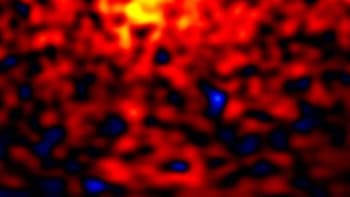
Two independent teams have shown that gravitational waves emanating from the distorted remnants of black-hole mergers should interact with themselves. By including these nonlinear effects in their models, one team, led by Keefe Mitman at Caltech, found it could replicate gravitational wave signals from simulated “ringing” black holes up to 100 times more accurately than previous approaches. The other team came to a similar conclusion and was led by Mark Ho-Yeuk Cheung at Johns Hopkins University
Following the violent and energetic merging of two black holes, the distorted black hole that is created must quickly settle into a state of equilibrium. To reach this steady state, the object releases colossal amounts of energy in the form of gravitational waves (GWs), in a process called black hole ringdown.
In 1973 a team led by Saul Teukolsky was the first to model GWs from ringdown – more than 40 years before the first GWs from merging black holes were detected by the LIGO observatory. Yet at the time, Teukolsky and colleagues only considered small distortions in remnant black holes, something that we now know is not a good description of what happens after a merger.
Large distortions
“Because black-hole mergers are so violent, the distortions of the final black hole are often large,” Mitman explains. “This means that we should expect nonlinear effects [such as] effects from the GW interacting with itself as it propagates through spacetime near the black hole, generating new waves.”
Despite this, astrophysicists have so far held to the idea that nonlinear effects must be too small to show up in observable GW signals. As a result, they have still only considered the linear effects calculated by Teukolsky’s team.
In one new study, Mitman, Teukolsky and colleagues employed a more advanced approach to modelling black hole ringdowns. Following a suggestion from team member Macarena Lagos at Columbia University, the team developed a new way to consider how a model could describe the self-interaction of the GWs emitted after black-hole mergers.
Lagos explains, “We have improved the GW model by including nonlinear interactions of gravity. We considered various numerical simulations of black-hole mergers, containing both linear and nonlinear interactions. We then quantified how well our nonlinear model reproduced the simulations.”
More precise model
Just as they predicted, the researchers’ new approach allowed them to replicate realistic GW signals far more closely than before. “By including this nonlinear term, rather than the more-familiar linear terms that Teukolsky helped discover, we can much more precisely model the GWs created in our numerical simulations,” Mitman continues. “This means that when black holes ringdown to a steady state, that ringing is a nonlinear process.”
By analysing various simulations of black-hole mergers, the team found that nonlinear effects can account for up to 10% of the GW signals – making them far more influential than previous studies had assumed. Altogether, this meant the team could model black-hole ringdowns some 100 times more accurate than purely linear approaches.

Caution needed when testing Einstein’s general relativity using gravitational waves
The team led by Cheung came to similar conclusions and together the results could have important implications for astronomers’ ability to probe the interior structures of black holes from the GW signals they emit during ringdowns. “To extract physical information from GW signals, we need very accurate analytical models that connect properties of the black holes to features in the detected signal,” Lagos explains. “Our results mean that the nonlinear effects are actually important and will be necessary to include in future GW detections.”
With a better understanding that ringdown is nonlinear in nature, the team hopes its discoveries could soon help astronomers to better explain the enigmatic behaviours of black holes.
Perhaps most importantly, they could also enable researchers to test Albert Einstein’s general theory of relativity – which governs black hole dynamics – in the most extreme environments known to astrophysics. With the precision offered by the team’s models, these tests may finally prove stringent enough to push Einstein’s theory to its limits – which could allow new and exciting physics to emerge. However, astrophysicists will have to wait until the next generation of GW observatories come online because the current LIGO–Virgo facilities are not expected to be able to detect nonlinear effects.
The research is described in Physics Review Letters.



